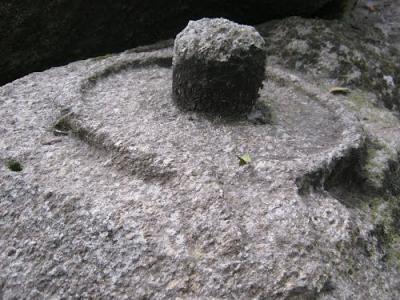|
According to the Kalika Purana written in the 10th Century B.C., Brahma created Pragjyotishpura as a city equal to the city of Indra – the King of the Devas. The word 'prag' refers to the 'east' and 'jyotisha' refers to star-astrology. Pragjyotisha is thus said to mean, 'eastern city of astrology'. The site is centered on the hills (Pahar) of Sri Surya which is profusely filled up with Shiva Lingas (Lingam). The popular belief is that 99999 Shiva Lingas were engraved here by Vyasa in order to build up a second Kashi (where there were 1,00000 Shiva Lingas) and once it was one of the holiest pilgrimage sites in the region. There is no historical evidence exactly how many Lingams once dotted in these hills, but still there are hundreds of them, from tiny to large in size, scattered everywhere at the foot of the hill and covering the extensive area after centuries of neglect and pilferage. The exact figure of the Lingas (and also other deities and relics) in the hill is yet to be counted scientifically.
A few years ago, some archaeologists unearthed a few Shiva Lingas and a few houses at Sri Surya - findings which confirmed the long-held belief that a thriving civilization held sway around Sri Surya Pahar some centuries ago. The intricate and scientific designs of the houses with artfully designed bricks led some archaeologists even to believe that more unearthing the history of Sri Surya Pahar would change the understanding of the history of ancient Assam and India. Some scholars even referred to the accounts of famous Chinese traveler Huen Tsang to claim that it was Sri Surya Pahar and not Guwahati that was the ancient land of Pragjyotishpur or Pragjyotisha Kingdom, the capital of the Kingdom of Kumar Bhaskara Varman (600-650). The findings of the nearby archaeological site of Paglatek are cited to strengthen this claim. Since Sri Surya Pahar is very close to the bank of Brahmaputra river, it might have been an important trade centre or seat of administration in the past.
Amongst the identified Jain figures in one of the first Tirthankara, Adinath, carved in sitting posture in the rocky ourcrop with two bulls in the base, also believed to be of the 9th century AD.
There also exist about 25 votive stupas of different sizes in the southern fringe of Sri Surya Pahar. The stupas are significant for it shows two points, . One ,that there was Buddhist influence in Kamarupa and two, much earlier then the rest of the country, because the design point to the early Hinayana stage of influence , earlier to the Mahayana and Vajrayana esotericism seen in Bihar and Bengal. Hinduism, Jainism and Buddhism all seem to have left their mark on this very sacred destination.
Archaeological excavations at the site have yielded numerous antiquities from the remains of two temple complexes datable from c. 6th to 12th century AD. Substantial terracotta art objects and stone antiquities are accumulated through these excavations. The noted discovery among the stone sculpture are the image of a Mahisasuramardini, stella fragments depicting kirttimukhas, Vidhyadaras, decorative objects, terracotta plaques, carved bricks, etc. Out of 173 antiquities in the museum, 93 are displayed in three galleries.
Opening Hours : 10.00 am to 5.00 pm
Closed on – Friday
Entrance Fee : Admission to Museum is Free
Sri Surya Pahar holds immense religious importance as it is evident from plenty of sculptures and relics belonging to Jainism, Buddhism and Hinduism. Another popular place located in the destination is Dadan Hill. The hill houses a temple at its peak that was constructed by the King of Sonipur, called Bana. The temple is dedicated to Lord Shiva and is visited by tourists in large numbers.
How to reach Sri Surya Pahar, Goalpara
Tourists travelling to Goalpara can avail flights, buses and trains. Those travelling by air can board flights to Lokpriya Gopinath Bordoloi International Airport located in Guwahati, which is the nearest airport serving the destination. This airport is located at a distance of 124 km from the destination.
Goalpara has its own train station wich is well connected with rest of India. The New-Delhi/Guwahati Sampark Kranti Express runs via Goalpara station. The Bongaigaon Junction is the another nearest railhead. Buses can also be boarded from different parts of India, which terminate at Goalpara Bus Stand. It is located at a distance of 1.3 km from Goalpara.
The best time to visit Goalpara is the winter season, which stretches from the month of October to February. The maximum temperature recorded during this season is around 23 degree Celsius, while the minimum temperature is 12 degree Celsius.
For more details about Goalpara click here. |



